S.S. GOVERNOR
The SS Governor was a 417-foot passenger liner built by the New York Shipbuilding Company in 1907 in Camden New Jersey. The deck plans list her beam at 46 feet, depth 29 ft. 6 in., Draft 22 ft. 6 in., and her max speed at 16 - 25 knots. She could accommodate 96 in her first class staterooms, and 286 in the first class berths, while her maximum passenger capacity was 427.
It was 12:04 a.m. on Friday April 1, 1921. The Governor was coming from San Francisco on her way to Seattle during a routine trip carrying 240 passengers and crew members. She had just dropped off some passengers in Victoria, Canada then headed southeast towards the Puget Sound. All was calm until she rounded Port Townsend.
The SS West Hartland, departing Port Townsend for India, came out of the dark and rammed into the Governor amidships on her starboard side, ripping open a 10- foot gash in the Governor’s iron hull. It was clear that night, and reports later stated that “the Governor’s pilot mistook the West Hartland’s running lights for fixed lights on Marrowstone Point and failed to yield the right-of-way”.
Point Wilson’s station keeper William J. Thomas, hearing the ship's whistles and sounds of the collision, telephoned authorities in Port Townsend with the information and rescue efforts were immediately organized.
The Governor immediately began taking on water. The captain of the West Hartland, Captain Alwen, acted quickly and ordered full speed ahead to try and keep the hole plugged with his ship. As the passengers and crew were clambering topside, matters were made worse with all power going out on the Governor. Now they had to act fast in the dark. Most of them were able to make it over to the West Hartland. Some weren’t so lucky.
The Washburn family was asleep when the impact occurred. On one side of the room the parents, Harry and Lucy. On the other side, their two girls, Sadie (8) and Olene (10). When the West Hartland hit, the bow sliced the Washburns room in half, seriously wounding Mr. Washburn, and trapping the two girls in their beds. Lucy managed to escape, bring help back, and remove the wet, weak, and wounded Mr. Washburn. But there was no way to free the sisters. Lucy presumably overcome with frantic rage, had to be forcibly taken away.
By this time the Governor was sinking fast, stern first. Most passengers were aboard the West Hartland, and Mr. Washburn was also moved to safety. Lucy on the other hand broke free of her rescuers and returned to the sinking ship to be with her beloved daughters. It is believed she was able to comfort small Sadie and Olene when they all went down with the ship. Since the collision, 20 minutes had elapsed.
The SS Governor took with her a total of eight lives.

The Governor’s pilot house that was towed into Port Townsends harbor the very next morning.
(All photos Courtesy Underwater Admiralty Sciences)
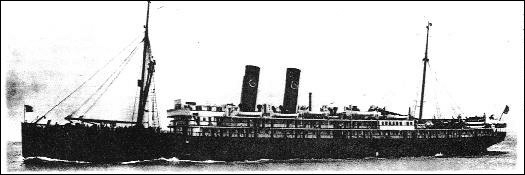
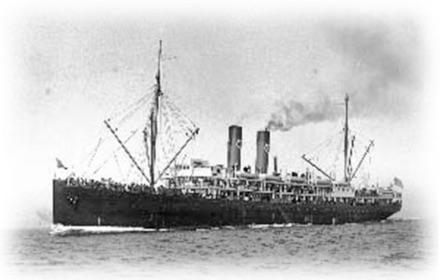
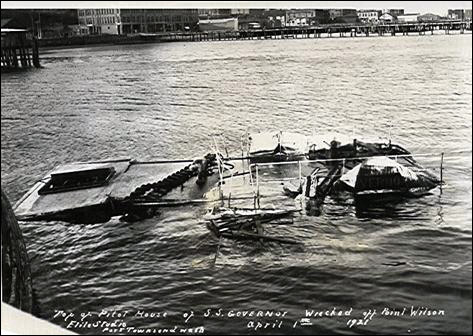
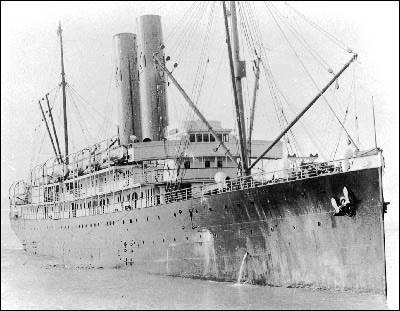
In 1919 the SS Governor had gone through an extensive upgrade. A wine locker and casino were added making her quite popular during prohibition. They had on board, of course, a casino safe, and that safe was rumored to hold inside large amounts of San Francisco $20 gold pieces.
THE SALVAGE ATTEMPT
In 1976 two commercial divers from Seattle, Kelly Finn and High Tides own Eric Morris, became the first divers to visit the wreck. Making just one dive, the two brought up several artifacts proving the Governors’ identity. They returned in 1981 with Steve Ballard and Russ Barnes making more dives to the wreck, bringing up china, bronze coat hooks, light fixtures, portholes, and various other items. No one yet tried for the safe.
During the spring of 1985, a group of historians and divers named the Argonaut Society headed up the next expedition. Kent Bernard, the president of the society, threw in $30,000 of his own cash, enlisted for additional funding, then let the media know there was to be a major operation to recover the safe. The coins believed to be inside, were said to be worth 1.5 million with each coin valued at $20,000.
They employed the use of a 2- man submarine for survey but abandoned the idea after the 4th failed attempt.

Another group, Northwest Salvage Ventures owned by Harry Truitt, was also preparing for operations to retrieve the safe. Realizing how expensive the task was going to be, he partnered up with Bernard, bringing an extra $120,000 to the table, along with the additional equipment for the job.
Only an hour after the first anchor was dropped over the wreck site, an incoming tug, towing three barges mistakenly tried to cut inside where the diving barge was anchored. With the currents raging everyone knew the barge was going to hit. The second barge hit, and the third hit broadside. The smaller diving scow was nearly capsized. Valuable time was lost with the repairs to the diving barge. With several attempts for salvage, Truitt called off the salvage saying, “It’s like an underwater hurricane down there.”
In 1987 Maritime Ventures gained salvage rights and stated they would raise the safes and historical artifacts. They estimated the value of said items would be worth around 4 million dollars. This assumption was based on one of the surviving passengers, Mrs. Vivian Small. She told a story of dreams her and her husband had of starting a glass business. They had brought with them a considerable amount of gold pieces to start up that business, and those pieces were in the Governor’s safe.
Robert Mester and Michael Lockwood led the new expedition to find the safe. Using some of their own funding, Mester had to also use artifacts to show off and lure in other potential investors. They called in Can-Dive of Canada, and with them they brought a 160 ft. diving barge, a diving bell, and hot water suits. For days divers Kery Donohue and Rick Patton lived in that bell, positioned over the Governor’s stern. Bob Mester and Bob Foster made several dives to video the work being done for a possible documentary later on.
The beaches were lined with spectators, press, and the authorities. The Coast Guard had to set up a safety perimeter to keep the dozens of spectator craft away.
The divers brought up several artifacts including, silverware, portholes, china, coat hooks, key plates, crystal, shoes, a fountain pen, ladies cosmetics, the captain’s plotter, a gold pocket watch, and ladies’ diamond rings. Also found was a safe deposit key, and the key plate was found the next day, but no gold pieces.
On one of the dives a large metal box was found, and upon closer examination a dial was located on the box. With a rush of excitement the divers moved it and all of a sudden heard a ticking sound. Confused, they asked topside if there was anything that should be ticking on the ship. Thinking that maybe they had struck gold, they examined closer and realized it was an old spring-wound clothes washer.
The tidal window was closed after 10 days of searching and Mester called off the diving. They had spent around $400,000 on the project and the 2 safes had not been found.
In August of 1992, Mester returned and made four heliox dives to the wreck in perfect conditions. These dives were some of the most productive ones ever made on the wreck. They explored the casino, and several other decks, bringing up more and more artifacts. The location of the casino safe was marked but in that area was piles of silt reaching six feet high. The safes have not yet been recovered.
From the article S.S. Governor by Eric Morris
Photo Steve Ladd
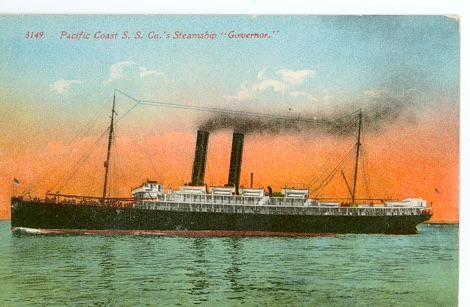
Courtesy Rob Wilson





-
-Home
